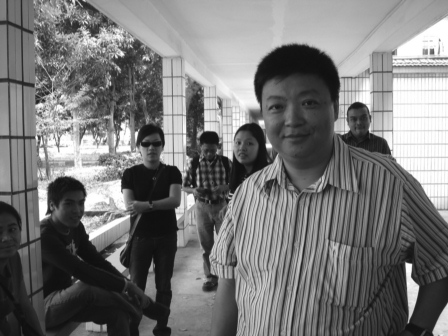AIDS Care Done Right
AIDS Care China Provides Case Study for ACATA Members
July 2007—Thomas Cai joined TREAT Asia’s Asian Community for AIDS Treatment and Advocacy (ACATA) in 2004 after founding a community support group for people with HIV/AIDS in his hometown of Guangzhou, China.
Since its creation six years ago, Thomas’s group, AIDS Care China, has grown from a shelter service for HIV/AIDS patients to a multi-site HIV/AIDS care program, with counseling and treatment education centers known as Red Ribbon Centers in four Chinese provinces—including a center supported by TREAT Asia in Hubei Province. Its community-based approach to combating HIV/AIDS has made it a widely recognized success story. Indeed last year, AIDS Care China received the high-profile Red Ribbon Award from the UN for its work supporting care and treatment of people living with HIV/AIDS.

Thomas Cai (right), flanked by fellow ACATA members, led a tour of health-care programs run by AIDS Care China in Nanning during a recent ACATA meeting. (Photo: Jennifer Ho) |
In April, ACATA members gathered in Nanning, China, for a meeting that focused on the work of their colleague Thomas and on AIDS Care China’s Red Ribbon Centers as a case study in effective, collaborative HIV care. Over the course of three days, ACATA members visited two hospital-based Red Ribbon Centers and a shelter for patients and their families, viewed a demonstration of a Red Ribbon Center computer program that helps track patient treatment, and analyzed those elements of Thomas’s organization and its community treatment support model that could best be implemented in their own countries.
ACATA members were impressed. “We have many health-care providers in our countries who will also pay lip-service to community collaboration and involvement, but here in Nanning, they actually put their words into practice,” said one ACATA member, shaking her head in disbelief as she toured one hospital’s sunny AIDS ward.
The goal of the Red Ribbon Centers is to improve treatment outcomes and adherence to medication, said Thomas. He and his staff quickly realized the importance of building good relationships with health-care providers and hospital officials. At first, he recalled, they experienced resistance from doctors and nurses, but they were slowly able to gain the trust of a handful of medical personnel.
This support grew when health-care providers began to recognize the invaluable role the Red Ribbon Center staff was playing in improving treatment understanding and adherence among patients. As a result, doctors and nurses urged their hospital board to provide AIDS Care China with space and support. At that point, a solid, collaborative relationship was born.
One of the most important lessons he has learned through AIDS Care China, said Thomas, is that “doctors have their areas of expertise; community members and people living with AIDS, we have our own areas of expertise. It is not a competition. Rather, we are here to complement each other’s work.”
The success of this collaborative model was demonstrated persuasively by a recent study that showed poor adherence to medication among only 4 percent of patients in Nanning supported by Red Ribbon Centers—far from the 40 percent at other local hospitals.
With the three-year cycle of the ACATA program coming to a conclusion this fall, members closed the meeting by reviewing their ACATA experience and discussing how best to apply their new-found knowledge and skills to their own countries. ACATA is supported in part by a grant from Postive Action.